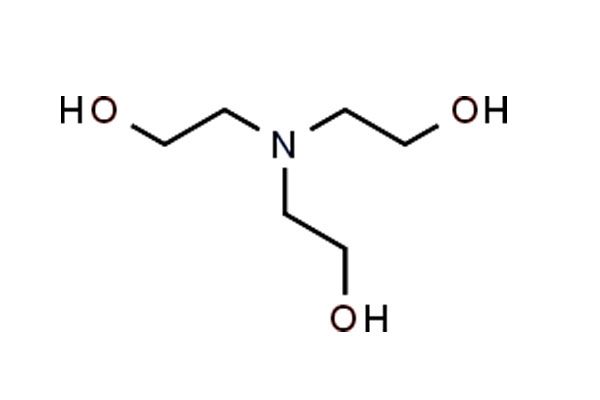Cas No: 102-71-6
EINESC No: 203-049-8
Molecular weight: 103.169 g/mol
Chemical Formula: C6H15NO3
Chemical Structure:
Physical Properties
General Properties: Colorless liquid
Odor: Similar to ammonia
Intensity: 1.124 g/mL
Boiling point: 335,40°C
Melting point: 21.60 °C
Flash point: 179°C
Vapor pressure: 1 Pa (20°C)
Refraction index: 1.485 nD
Solubility (aqueous) completely miscible

General Properties
Triethanolamine, or TEOA, is a sticky liquid that is both tertiary amine and triol. It is a very strong alcali. The pH value of its 1% solution is approximitely 10. Although it is colorless in pure form, it may take up a yellow color because of impurities it contains. TEOA is a very good fat solvent and a pH stabilizer. Therefore, it is preferred in both industry and consumer products.
Triethanolamine is also used in production of certain chemical weapons.
Production
Triethanolamine is acquired from reaction of ethylene oxide and aqueous ammonia.
Applications
Triethanolamine is used in surface active substance production such as emulgators. It is also used in sunscreen, laundry detergent, washing liquid, antifreeze, disinfectant, polish, dye, corrosion blocker and ink production.
It is used as additive substance for grinding klinkers in cemet production. It eases grinding process by preventing dust from coagulation, thus, preventing it from sticking on the surface of the mill.
It is also an active compound for medicine droppers which are use to treat ear diseases and infections.
It also serves as a pH stabiizer in many different industries.
It is also used as intermediate in oil demulsifiers. It is used as catalyst for polyurethane resins in polymerizing agents. It works as a rubber vulcanization trigger.
It is also used in amateur photography, holography, ultrasonic tests and aluminium solders.
Safety Measures and Toxic Values
Triethanolamine (EC) No 1272/2008 is classified as hazardous material. However, studies suggest that it causes allergies on skin from time to time. It is also considered to be dangerous to underwater life. It is carcinogenic for rodents.
It has more intensity than air and it is flammable. When it burns, it releases poisonous gases such as nitrogen oxide.